Kingdom Animalia Class Mammalia Infraclass Eutheria | Phylum Chordata Subclass Theria | |
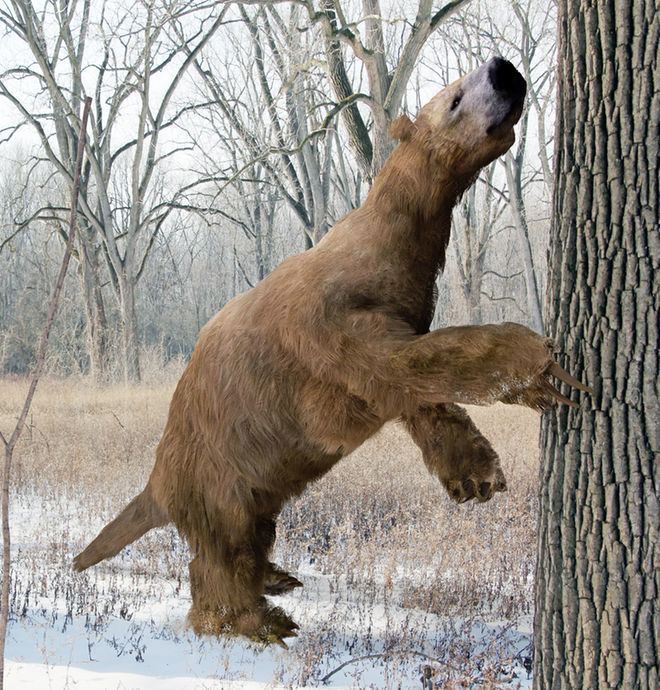 | ||
Gestation period Pale-throated sloth: 183 days Daily sleep Brown-throated sloth: 15 – 18 hours Mass Brown-throated sloth: 2.2 – 6.3 kg, Pale-throated sloth: 3.8 – 6.5 kg, Maned sloth: 4.5 – 10 kg Length Brown-throated sloth: 42 – 80 cm, Pale-throated sloth: 50 – 75 cm, Maned sloth: 55 – 75 cm Tail length Brown-throated sloth: 2.5 – 9 cm, Pale-throated sloth: 4 – 6 cm, Maned sloth: 5 cm Size of territory Brown-throated sloth: 0.005 – 0.09 km², Maned sloth: 0.005 – 0.06 km² Representative species | ||
Ground sloths are a diverse group of extinct sloths, in the mammalian superorder Xenarthra. The term "ground sloth" is used as a reference for all extinct sloths because of the large size of the earliest forms discovered, as opposed to the extant "tree sloths." However, this is a historical convention and should not imply that all extinct sloths were strictly terrestrial in nature. Their most recent survivors lived in the Antilles, where it has been proposed they may have survived until 1550 BCE; however, radiocarbon dating suggests an age of between 2819 and 2660 BCE for the last known occurrence of Megalocnus in Cuba. Ground sloths had been extinct on the mainland of North and South America for 10,000 years or more. Their later survival in the Caribbean correlates with the later colonization of this area by humans. Some insular sloth populations persisted 5,000–6,000 years longer than their continental mainland relatives, in congruence with the global pattern of late Quaternary large vertebrate extinction due to human dispersal.
Contents
- Short faced bear vs ground sloth
- Families
- Megalonychidae
- Megatheriidae
- Nothrotheriidae
- Mylodontidae
- Orophodontidae
- Scelidotheriidae
- Extinction in North America
- Hunting weapons
- Advantages
- Difficulties
- References
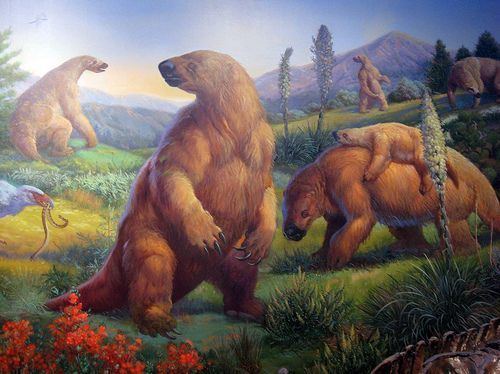
The bulk of ground sloth evolution took place during the mid to late Tertiary of South America while the continent was isolated. At their earliest appearance in the fossil record, the ground sloths were already distinct at the family level. The presence of intervening islands between the American continents in the Miocene allowed a dispersal of forms into North America. A number of mid- to small-sized forms are believed to have previously dispersed to the Antilles islands either by making short swims or using land bridges. Ground sloths were a hardy group as evidenced by their diverse numbers and dispersals into remote areas given the finding of their remains in Patagonia (Cueva del Milodón) and parts of Alaska.
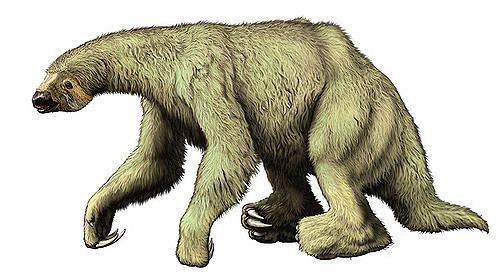
Sloths, and xenarthrans as a whole, represent one of the more successful South American groups during the Great American Biotic Interchange. During the interchange, many more taxa moved from North America into South America than in the other direction. At least five genera of ground sloths have been identified in North American fossils; these are examples of successful immigration to the north.

Short faced bear vs ground sloth
Families
Paleontologists assign more than 80 genera of ground sloths to multiple families.
Megalonychidae
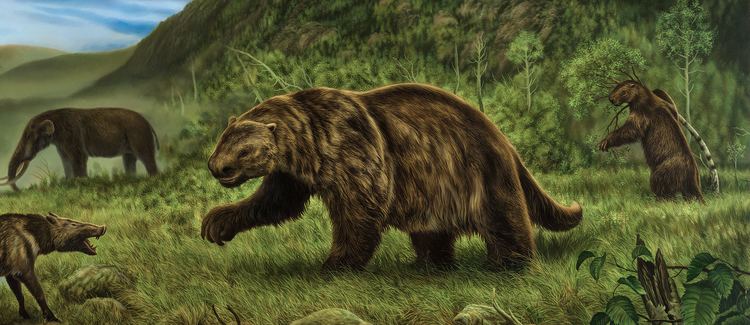
The megalonychid ground sloths first appeared in the early Oligocene, about 35 million years ago, in Patagonia. Megalonychids first reached North America by island-hopping, prior to the formation of the Isthmus of Panama. Some lineages of megalonychids increased in size as time progressed. The first species of these were small and may have been partly tree-dwelling, whereas the Pliocene (about 5 to 2 million years ago) species were already approximately half the size of the huge Late Pleistocene Megalonyx jeffersonii from the last ice age. Some West Indian island species were as small as a large cat; their dwarf condition typified both tropical adaptation and their restricted island environment. This small size also enabled them a degree of arboreality.

Megalonyx, which means "giant claw," was a widespread North American genus that lived past the close of the last (Wisconsin) glaciation, when so many large mammals died out. Remains have been found as far north as Alaska and the Yukon. Ongoing excavations at Tarkio Valley in southwestern Iowa may reveal something of the familial life of Megalonyx. An adult was found in direct association with two juveniles of different ages, suggesting that adults cared for young of different generations.
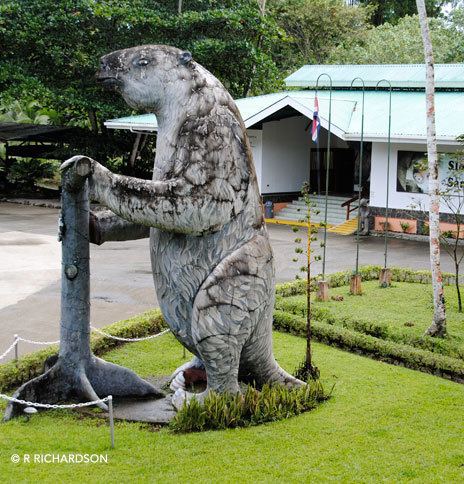
The earliest known North American megalonychid, Pliometanastes protistus, lived in the southern U.S. about 9 million years ago and is believed to have been the predecessor of Megalonyx. Several species of Megalonyx have been named; in fact it has been stated that "nearly every good specimen has been described as a different species". A broader perspective on the group, accounting for age, sex, individual and geographic differences, indicates that only three species are valid (M. leptostomus, M. wheatleyi, and M. jeffersonii) in the late Pliocene and Pleistocene of North America, although work by McDonald lists five species. Jefferson's ground sloth has a special place in modern paleontology, for Thomas Jefferson's letter on Megalonyx, read before the American Philosophical Society of Philadelphia in August 1796, marked the beginning of vertebrate paleontology in North America. When Lewis and Clark set out, Jefferson instructed Meriwether Lewis to keep an eye out for ground sloths. He was hoping they would find some living in the Western range. Megalonyx jeffersonii was appropriately named after Thomas Jefferson.
Megatheriidae
The megatheriid ground sloths are relatives of the megalonychids; these two families, along with the family Nothrotheriidae, form the infraorder Megatheria. Megatheriids appeared later in the Oligocene, some 30 million years ago, also in South America. The group includes the heavily built Megatherium (given its name 'great beast' by Georges Cuvier) and Eremotherium. The skeletal structure of these ground sloths indicates that the animals were massive. Their thick bones and even thicker joints (especially those on the hind legs) gave their appendages tremendous power that, combined with their size and fearsome claws, provided a formidable defense against predators.
The earliest megatheriid in North America was Eremotherium eomigrans which arrived 2.2 million years ago, after crossing the recently formed Panamanian land bridge. With more than five tons in weight, 6 meters in length, and able to reach as high as 17 feet (5.2 m), it was larger than an African bush elephant bull. Unlike relatives, this species retained a plesiomorphic extra claw. While other species of Eremotherium had four fingers with only two or three claws, E. eomigrans had five fingers, four of them with claws up to nearly a foot long.
Nothrotheriidae
Recently recognized, ground sloths of Nothrotheriidae are often associated with those of the Megatheriidae, and together the two form the superfamily Megatheroidea. The most prominent members of the group are the South American genus Thalassocnus, known for being aquatic, and Nothrotheriops from North America.
The last ground sloths in North America belonging to Nothrotheriops died so recently that their subfossil dung has remained undisturbed in some caves. One of the skeletons, found in a lava tube (cave) at Aden Crater, adjacent to Kilbourne Hole, New Mexico, still had skin and hair preserved, and is now at the Yale Peabody Museum. The American Museum of Natural History in New York City has a sample of dung with a note attached to it that reads "deposited by Theodore Roosevelt". The largest samples of Nothrotheriops dung can be found in the collections of the Smithsonian Museum. Another Nothrotheriops was excavated at Shelter Cave, also in Doña Ana County, New Mexico.
Mylodontidae
The mylodontid ground sloths together with their relatives the scelidotheriids and the orophodontids form the Mylodonta, the second radiation of ground sloths. The discovery of their fossils in caverns associated with human occupation led some early researchers to theorize that the early humans built corrals when they could procure a young ground sloth, to raise the animal to butchering size. However, radiocarbon dates do not support simultaneous occupation of the site by humans and sloths. Subfossil remains like coproliths, fur and skin have been discovered in some quantities.
Orophodontidae
The formerly recognized ground sloth family Orophodontidae constitutes a rather small but quite distinct group. They have been classified as a distinct mylodontan superfamily Orophodontoidea, the sister taxon to the Mylodontoidea. The taxon is now often disused with genus members reassigned to Megalonychidae and Mylodontidae.
Scelidotheriidae
The formerly recognized ground sloth family Scelidotheriidae was demoted in 1995 to the subfamily Scelidotheriinae within Mylodontidae. Together with the rest of Mylodontidae and the engimatic Pseudoprepotherium, the scelidotheriines form the superfamily Mylodontoidea. Chubutherium is an ancestral and very plesiomorphic member of this subfamily and does not belong to the main group of closely related genera, which include Scelidotherium and Catonyx.
Extinction in North America
Radiocarbon dating traces the disappearance of ground sloths in the United States to around 11,000 years ago. Steadman et al. argue that it is no coincidence that studies have shown that the disappearance of ground sloths occur a few years after humans inhabited their living areas, however, recent scientific work is beginning to reveal that climate change had much more of an impact on the decline of the mega fauna in North America.
Those that argue in favor of the claim that humans are the direct cause of the ground sloths’ extinction point out that the few sloths that remain are small sloths that spend most of their time in trees, making it difficult for them to be spotted by humans. Although these sloths were sufficiently hidden, they still would have been affected by the climate changes that supposedly wiped out the ground sloths. Additionally, after the continental ground sloths disappeared, insular sloths of the Caribbean remained for approximately 6,000 years longer (these islands were not colonized by humans until about 5500 yr BP).
It is difficult to find evidence that supports either claim on whether humans hunted the ground sloths to extinction. Removing large amounts of meat from large mammals such as the ground sloth requires no contact with the bones; tool-inflicted damage to bones is a key sign of human interaction with the animal.
Hunting weapons
Past theories of how the first people came into the New World stated that they arrived via the Bering Bridge that connected Asia and North America. The theory stated these nomads descended from hunting families and had acquired the skills to track down and kill large mammals. By this time, humans had developed preliminary weapons used for hunting. These weapons included the Clovis points, which were narrow, carved stone projectiles used specifically for big game. A couple hundred years later, humans had established the atlatl, an invention that allowed them to throw spears at their prey. These inventions allowed hunters to put distance between them and their prey, potentially making it less dangerous to approach these ground sloths.
Advantages
Certain characteristics and behavioral traits of the ground sloths made them easy targets for human hunting and provided hunter-gatherers with strong incentives to hunt these large mammals.
Ground sloths often fed in open fields. Recent studies have attempted to discover the diet of ground sloths through fossils of their dung. Analysis of these coproliths have found that ground sloths often ate the foliage of trees, hard grasses, shrubs, and yucca; these plants were located in areas that exposed them. Feeding in open areas made them susceptible to human interaction. Ground sloths were not only easy to spot, but also had never interacted with humans before. They did not know how to react to these new beings. Additionally, these large mammals waddled on their hind legs and front knuckles, keeping their claws turned in. Their movement and massive build (some weighed up to 3,000 kilograms) imply they were relatively slow mammals. These constitute intuitive reasons why ground sloths would have been easy prey for hunters.
Difficulties
Although ground sloths were relatively easy to spot, this did not make hunting them easy. Big game hunters' weapons were useless if ground sloths were further than thirty feet away. Additionally, the ground sloths' already thick hide consisted of osteoderms, which made it exceptionally thick. It was difficult to take down a ground sloth with a spear-thrower; killing a ground sloth required extensive knowledge of the species. Ground sloths' size and claws strong enough to tear apart tree branches made it dangerous for hunters to approach these animals.
